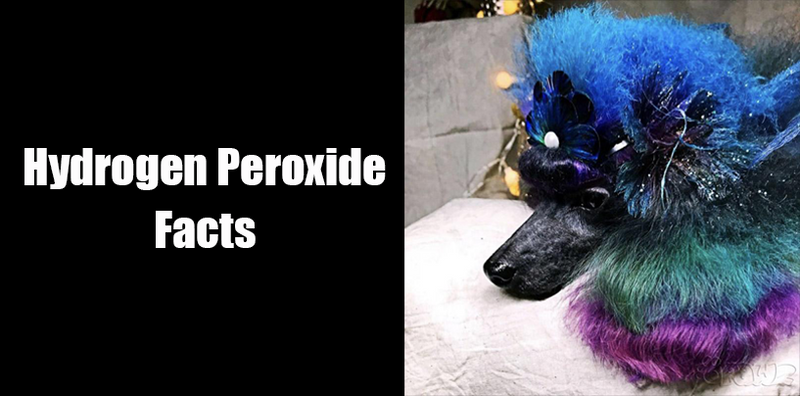Candy Hepple
Dyed onto brown fur without using lightening cream with OPAWZ Permanent Pet Hair Dye (Adorable Pink).
Products Used: OPAWZ Permanent Dyes (Adorable Pink)
Save 20% on individual dyes and shampoos!
Today only until 11:59pm EST
00
Days
:00
Hours
:00
Mins
:00
Secs

We all know that hydrogen peroxide is an ingredient that is included in most commercial hair dyes. It is an easy way to brighten the hair or bring out hair’s natural highlights.
When it comes to safety for dogs, whether something can be deemed safe or not, generally boils down to much they’re receiving and where it’s going.
First of all, understanding your dog’s skin condition is important while doing creative grooming.
We must keep in mind that canine skin and human skin are not the same.
There are approximately 20-25 layers to the human epidermis and there are only 8-10 layers to the canine epidermis. It tells us that canine skin is more fragile than human skin.
That’s why before hair dyeing your dog you should always check if there’s any irritated or damaged skin. Creative groomers should only use pet labeled hair dyes.
OPAWZ it’s a professional creative grooming products brand especially developed for pets, all of our products are none-animal tested.
The use of Hydrogen Peroxide can give the hair a slightly lighter coat for a few days but as soon as the oils in the dog’s skin come back it goes away. Normally the dark-haired coat was lightened for a better coloring result in creative grooming.

Always test it on a small patch of skin and read the application manually before using. Care must be taken to prevent the dog from licking his coat while the color processes. Careful to keep the hydrogen peroxide out of your dog’s eyes, nose, and mouth.
To lighten dark fur with OPAWZ Lightening Cream and preparing it for dog dye, always make sure the pet is completely comfortable, safe and secure throughout the entire creative grooming process. Their health and safety should always be a top priority in any creative work.
Product reference: OPAWZ lightening cream
Recommended rich years of creative grooming experience ONLY. Always check the skin’s health before use. Avoid pets that are old, scared/aggressive or have health issues.
*If used incorrectly, the product may have a higher risk of allergic reactions or burns on the skin. Read the instructions carefully.
**FOR PROFESSIONAL USE ONLY**

Dyed onto brown fur without using lightening cream with OPAWZ Permanent Pet Hair Dye (Adorable Pink).
Products Used: OPAWZ Permanent Dyes (Adorable Pink)

Products Used: OPAWZ Permanent Pet Hair Dyes

Products Used: OPAWZ Lightening Cream, OPAWZ Permanent Pet Hair Dyes

Products Used: OPAWZ Lightening Cream, OPAWZ Permanent Dog Hair Dye

Hair lightened prior to using OPAWZ Permanent Pet Hair Dye (Adorable Pink), black coat refreshed with OPAWZ Super Black Dog Hair Dye
Products Used: OPAWZ Permanent Pet Hair Dye (Adorable Pink), OPAWZ Super Black Pet Hair Dye

Products Used: OPAWZ Lightening Cream, OPAWZ Permanent Pet Hair Dye

Products Used: OPAWZ Lightening Cream, OPAWZ Permanent Dog Hair Dye

Products Used: OPAWZ Permanent Pet Hair Dye

Products Used: OPAWZ Lightening Cream, OPAWZ Permanent Pet Hair Dyes
If your dog ingests items, chemicals or foods that have the potential to be dangerous or even toxic, as awful as it may sound, you can use hydrogen peroxide on dogs’ to actually induce vomiting.
Hydrogen peroxide is an irritant to the dog's intestinal tract. Basically, once it is swallowed, it generates oxygen bubbles in the stomach. When there are enough bubbles, they stretch the dog's stomach and trigger vomiting.
According to veterinarian Dawn Ruben. Most vets say that you should stick to a 0.5-1 ml (depending on the size of your dog) dose of 3% hydrogen peroxide per pound of weight. Do not exceed 50 ml no matter what.
Let’s look at another use. Hydrogen peroxide is chemically similar to water. Where water is H2O, hydrogen peroxide has an extra molecule of water, making it H2O2. It occurs naturally in very small amounts when we breathe out.
We know this chemical has some antiseptic ability, the ability of this chemical to kill some bacteria through an oxidation reaction is well known, and there’s no denying the use of hydrogen peroxide is controversial.
The reason is the difference between killing bacteria and healthy tissue is all a matter of dilution.
The satisfying fizz of neat peroxide as it kills bacteria can also damage living tissue. But, when diluted appropriately (for every 1 part of 3% hydrogen peroxide, dilute it in 3 parts water), it makes a useful disinfectant and is considered safe on minor wounds.
If your pet has a minor wound, clean it up with hydrogen peroxide and monitor for signs of infection. Cleaning is the best thing to do, and by balancing the risks, you do more good than harm.
Emmy award-winning veterinarian Dr. Jeff Werber confirms that hydrogen peroxide is safe for cleaning small wounds on your dog.
“Hydrogen peroxide should not be used or poured into a large, open wound,” Dr. Werber explains. If your dog has a large wound, seek immediate attention from your veterinarian.
As mentioned above, hydrogen peroxide for dogs should never be applied at its full strength to clean a wound. Before using hydrogen peroxide for dogs, dilute it with either water or saline.
Hydrogen peroxide can be used initially on a wound to decontaminate it, but it should not be used repeatedly. If you do use it on a wound, use only after the initial cleaning and do not repeat.
This pet health content was written by a veterinarian, Dr. Pippa Elliott, BVMS, MRCVS.
0 Item(s)
0 comments